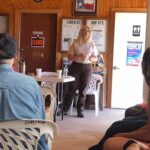
The DMR Firewise Community has a designated Facebook page!
The Davis Mountains Resort Firewise Community

INTRODUCTION: Davis Mountains Resort is located in what national, state & local fire-fighters refer to as the Wildfire Bullseye of Texas. That’s why in 2012 DMR became a Firewise Community recognized by FIREWISE USA. We are one of two communities in the Trans Pecos to be so designated (McDonald Observatory being the other). Firewise USA’s “Firewise Communities Program” is a project of the National Fire Protection Association and is co-sponsored by the USDA Forest Service, the Department of the Interior and the Texas Forest Service. DMR’s Firewise Community is sponsored by the Davis Mountains Resort Volunteer Fire Department.
MISSION STATEMENT: The primary goal of the Firewise Program is to encourage and assist DMR property owners who desire to improve their wildfire preparedness. Participating in Firewise is voluntary – if you choose to take part, any actions you take on your property are entirely up to you. All of our efforts, whether part of or independent from Firewise, are multiplied when taken as a whole – the sum is greater than its parts!
WHY BE FIREWISE?
• Learn new steps you can take to enhance your property’s defensibility.
• Develop an Evacuation Plan for you and your family.
• Create a framework for coordinated action by DMR’s Firewise Community
• Learn about Wildfire.
• Have peace of mind from knowing you are “READY”.
• Build a stronger sense of Community in DMR.
• Generate positive publicity and pride for DMR.
HELPFUL LINKS:
• Firewise USA, Get Started: Prepare your home and property.
• Ready for Wildfire – Ready Set Go: Plan, Know, Act!
• DMR Firewise Owl Gear: Support DMR Firewise – buy a t-shirt, etc!
• DMR Volunteer Fire Department: Sponsor of our Firewise Community.
• Texas Forest Service Predictive Services: Fire Potential Updates.
• Incident Information System (InciWeb): Track active wildfires.
What is Firewise?
The Firewise Program has its origins in the 1985 fire season during which 1,400 homes were destroyed making fire managers acutely aware that the “wildland urban interface” where residences mix with undeveloped forest and open lands was an unavoidable reality of contemporary firefighting. It’s also a problem that it is national in scope; in other words, wherever there are forests. The term “Firewise” was coined in the early 1990s to identify the growing knowledge that landowners could use to reduce their fire risks. A website by this name was launched in 1997 by the National Fire Program Association.
Focused first on simply raising awareness of the potential for fires in semi-urban settings, Firewise program managers moved on quickly to the task of developing and providing information about the simple and practical techniques homeowners could use to reduce the risks of home destruction by wildfire.
The two greatest risks to homes during wildfires are: 1) Flammable roof, vulnerable to the embers thrown during a wildfire and, 2) Vegetation close to a house which can catch fire and generate enough heat or flames to ignite siding or other parts of the home’s structure.
Firewise went to work with this information to learn more about how structures burn and, in particular, what causes them to ignite. This led to the “International Crown Fire Experiments” of 1998 in the Northwest Territory. Scientists set large fires in, on and near structures of various types to obtain high quality data about how close vegetation could be to a structure yet not put that structure at risk of igniting from radiant heat. The three main takeaways from this research were that you can significantly reduce your fire risk by: Clearing flammable trees and shrubs 30 feet or more from structures, Making sure small flames in grass or shrubs cannot touch the home, and Using nonflammable roof materials to minimize the damage that embers can cause. With reliable, quantitative data in hand, Firewise and its partners disseminated information broadly with the primary message being “Your home CAN survive a wildfire.” Publications and videos are great tools but hands-on workshops put homeowners in direct contact with experts and enable attendees to ask specific questions about home materials, vegetation options and other factors that may affect their home’s survivability.
Firewise workshops are designed to assist community “spark plugs” and provide them the technical information they need to make a compelling case for becoming Firewise, as well as provide a flexible tool kit they can use to encourage community involvement and match need to the community in which they live.
For full article, go to: https://foreststewardshipnotes.wordpress.com/2016/03/03/what-is-firewise-and-why-to-attend-a-firewise-workshop/





